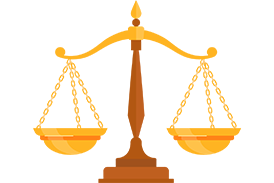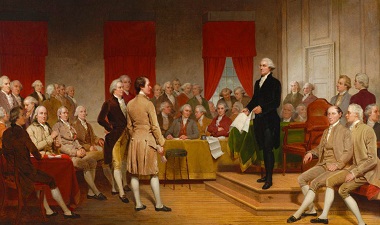
Getting Started
This module includes an Unboxing the Constitution video (5 min), Inside the Constitution video (5 min), student activities, and a learning project. Download the Teachers Guide and the Student Content Guide for more details on content and implementation. Course materials are provided in Google documents, Word documents, as well as printable PDFs.
A preview of the module can be accessed below.
Topics covered include:
- Influences on the Bill of Rights
- Arguments about the Bill of Rights
- Bill of Rights Walkthrough
- Connections to the 14th Amendment

Vocabulary
At the beginning of each module, students are presented with vocabulary words and definitions.
Concept Words
Concept words are conceptually related to the big ideas in what they’re learning. These connect directly to the core concepts or themes of the lesson or unit and help students grasp the main ideas and how everything fits together.
- amendment: a change or addition made to a document, like the Constitution
- due process: the process the government must follow in order to take away anyone’s life, liberty, or property
- enumeration: to list things in an organized way
- incorporation: the process by which parts of the Bill of Rights were made to apply to state and local governments, rather than just the federal government
Speed Bump Words
Speed bump words are words that aren’t central to the concept being taught, but if students don’t understand them, they may struggle to comprehend the text or lesson. These words can help shape students' overall understanding of the topic.
- affirm: to state as a fact
- deprived: to have something taken away
- dissent: to disagree with something, such as an opinion
- militia: a group of citizens trained to act as soldiers, but who are not part of a regular military
- oath: a promise, spoken or written, to follow certain standards and uphold certain principles
- quartered: given housing, usually used to refer to the housing of soldiers either in barracks or in a private person’s home
- seizure: to take possession of another’s property
- warrant: a legal document giving law enforcement the authority to act in a certain way, such as to search a home or arrest a person

Topic 1: Why a Bill of Rights?
At the end of the Constitutional Convention, three delegates dissented and chose not to sign the Constitution: George Mason, Elbridge Gerry, and Edmund Randolph. They believed that without a bill of rights, the Constitution gave the federal government too much power. After the Constitutional Convention, the Constitution still needed to be ratified by the states before it could become the law of the land. As the debate over ratification proceeded at the state level, two sides emerged. We know them as the Federalists and the Anti-Federalists. Federalists wanted to see the Constitution ratified unchanged, and Anti-Federalists opposed the ratification. Including (or not!) a bill of rights was an important issue for Federalists and Anti-Federalists.
5.1: Activate Prior Knowledge
To start engaging with the content from this module, students will brainstorm ideas about three statues from the National Constitution Center’s Signers’ Hall. Think about questions like:
- What did the artist want to express with these statues?
- Why do you think the artist posed them this way?
- Why might dissent be important?
- What else do you notice?
Unboxing the Constitution
In this Unboxing the Constitution video, Lucy explores the call for a Bill of Rights during the ratification process, and how the rights included were shaped.
5.2: Explore Both Sides
Students will watch the Inside the Constitution video and use the Video Guide notes as they learn about the Bill of Rights, where it came from, and the people who both supported and opposed it.
Inside the Constitution
5.3: Looking at Primary Sources
Why wasn’t a Bill of Rights part of the Constitution in the first place? What were some of the concerns about adding one, or not adding one? Students will explore different primary sources that highlight these arguments and more.
Review the Teachers Guide for this module for primary source implementation tips.
5.4: Where Did the Bill of Rights Come From?
Students will read portions of the Virginia Declaration of Rights, which served as a model for the Bill of Rights and consider similarities and differences they notice.
5.5: Closing Activity
Students will check in on the Key Question(s).

Topic 2: Ten New Amendments
State constitutions provided some foundation for what would eventually become the Bill of Rights. In some cases, even the language is similar. Explore state constitutions and other guiding documents that helped shape the Bill of Rights.
5.6: A First Amendment
How did state constitutions influence the Bill of Rights? Students will explore some examples, draw connections, and consider themes they may notice.
5.7: What's in the Bill of Rights?
What are some big ideas in the amendments that make up the Bill of Rights? How do the big ideas compare across all ten amendments? Students will read through the Bill of Rights to build these connections and understandings.
5.8: The 14th Amendment: A Sneak Peek
Students will explore the relationship between the Bill of RIghts and the 14th Amendment, through a timeline of cases, legislation, and constitutional events. How are these two pieces of the Constitution connected?
5.9: Civic Connection: Your Rights
In this Civic Connection activity, students will create a sales pitch to share their ideas on what makes the Bill of Rights exciting and important.
5.10: Reflect
To end this module, students will revisit the brainstorming activity and Key Questions from the beginning of the module to see how insights have grown throughout the lesson.

Learning Project: The Bill of Rights Debut
In this project, students will have the opportunity to express their own thoughts about the debates over the Bill of Rights. Students will read the powerful and persuasive arguments used to convince the Federalists to add a bill of rights and the arguments that convinced Anti-federalists to agree to the addition. Students will create their own song or scene about the Bill of Rights.













